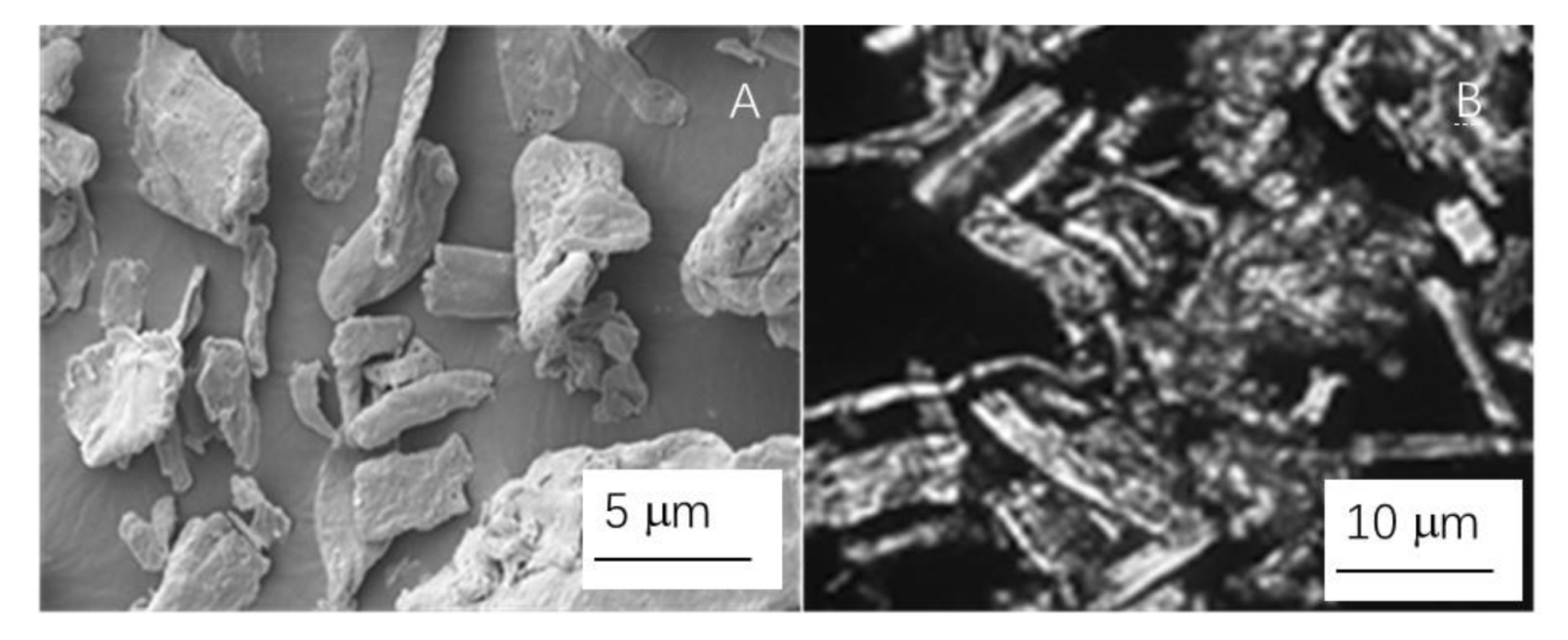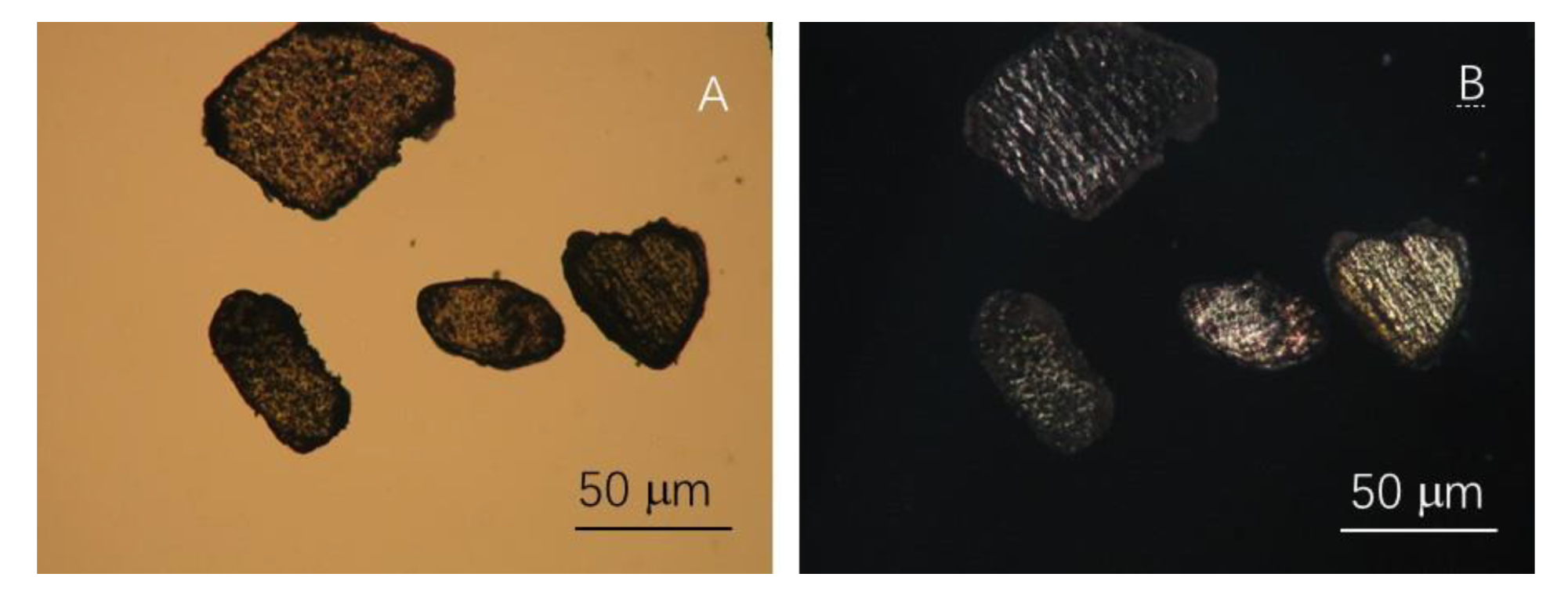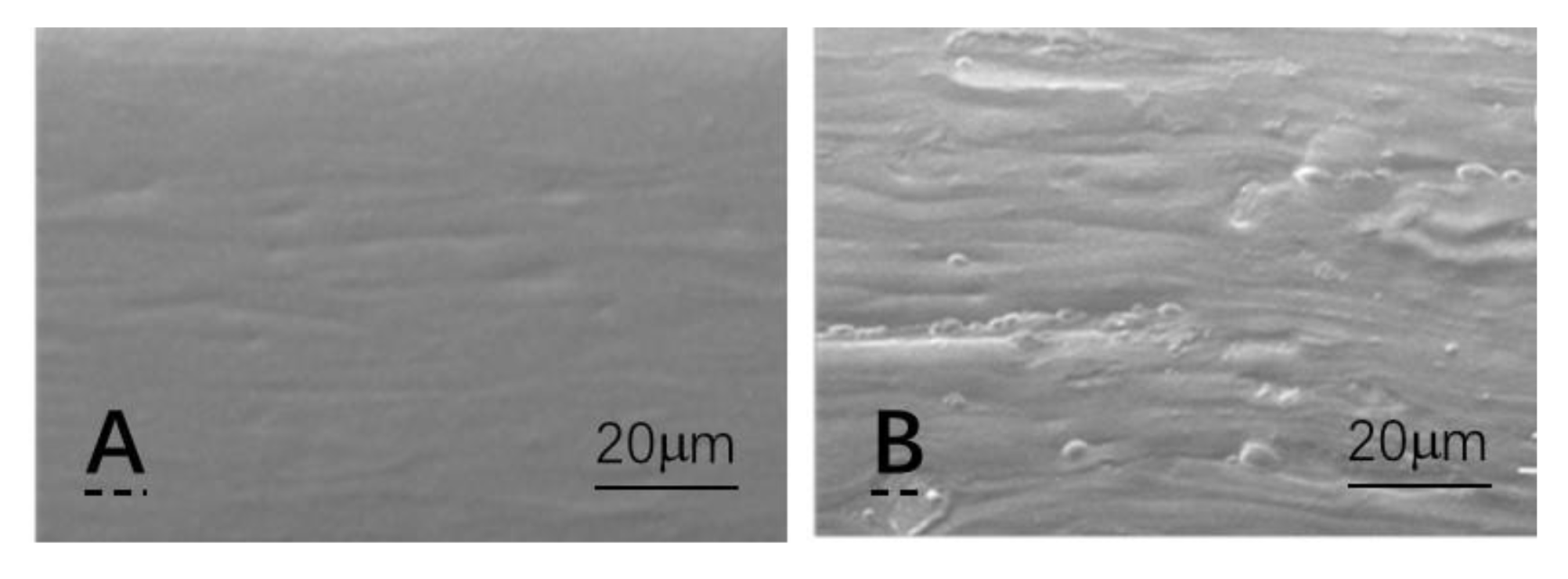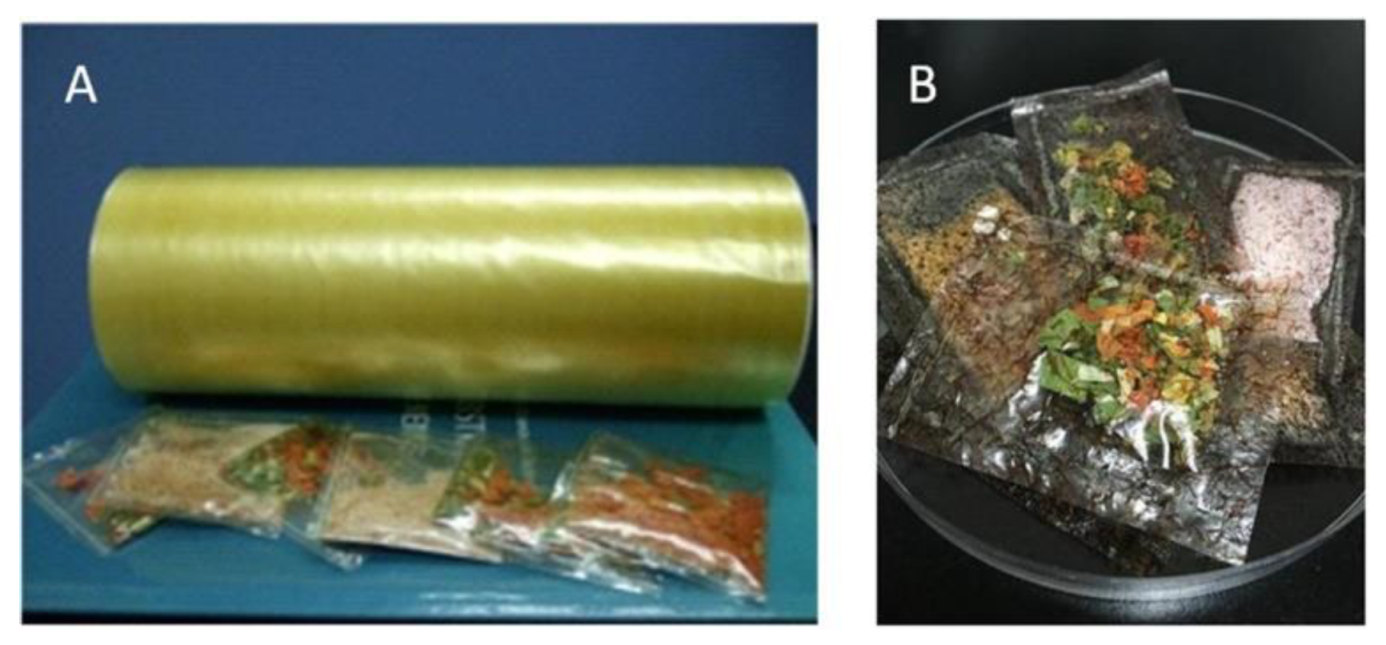Developing Edible Starch Film Used for Packaging Seasonings in Instant Noodles
Abstract
:1. Introduction
2. Materials and Methods
2.1. Materials
2.2. Sample Preparation
2.3. Tensile Characteristics
2.4. Moisture Effect and Permeability
2.5. Characterization of Microstructure and Morphology
2.5.1. Scanning Electron Microscope (SEM)
2.5.2. Optical Microscope (OM)
2.6. Statistical Analysis
3. Results
3.1. Effect of Various Additives on Performance of Starch-Based Film
3.1.1. Effect of Cellulose Crystals
3.1.2. Effect of Laver
3.1.3. Effect of Xylose
3.2. Morphologies and Interface
3.2.1. Surface Morphologies
3.2.2. Interface
3.3. Developing Flavor Bag Packaging
4. Discussion
5. Conclusions
Author Contributions
Funding
Institutional Review Board Statement
Informed Consent Statement
Acknowledgments
Conflicts of Interest
References
- Patel, P. Edible packaging. ACS Cent. Sci. 2019, 5, 1907–1910. [Google Scholar] [CrossRef] [PubMed] [Green Version]
- Zhao, Y.; Li, B.; Li, C.; Xu, Y.; Luo, Y.; Liang, D.; Huang, C. Comprehensive Review of Polysaccharide-Based Materials in Edible Packaging: A Sustainable Approach. Foods 2021, 10, 1845. [Google Scholar] [CrossRef]
- Brody, A.L. Packaging, food. Kirk-Othmer Encycl. Chem. Technol. 2005, 2, 65–66. [Google Scholar] [CrossRef]
- Debeufort, F.; Quezada-Gallo, J.; Voilley, A. Edible films, and coatings: Tomorrow’s packaging: A review. Crit Rev. Food Sci. Nutr. 1998, 38, 299–313. [Google Scholar] [CrossRef] [PubMed]
- Chen, Y.; Yu, L.; Ge, X.; Liu, H.; Ali, A.; Wang, Y.; Chen, L. Preparation and characterization of edible starch film reinforced by laver. Int. J. Biol. Macromol. 2019, 129, 944–951. [Google Scholar] [CrossRef] [PubMed]
- Zhu, J.; Chen, H.; Lu, K.; Liu, H.-S.; Yu, L. Recent progress on starch-based biodegradable materials. Acta Polym. Sin. 2020, 51, 983–995. [Google Scholar] [CrossRef]
- Ali, A.; Xie, F.; Yu, L.; Liu, H.; Meng, L.; Khalid, S.; Chen, L. Preparation and characterization of starch-based composite films reinforced by polysaccharide-based crystals. Compos. Part B 2018, 133, 122–128. [Google Scholar] [CrossRef]
- Ali, A.; Yu, L.; Liu, H.; Khalid, S.; Meng, L.; Chen, L. Preparation and characterization of starch-based composite films reinforced by corn and wheat hulls. J. Appl. Polym. Sci. 2017, 134, 45159. [Google Scholar] [CrossRef]
- Deore, U.V.; Mahajan, H.S. Isolation and characterization of natural polysaccharide from Cassia Obtustifolia seed mucilage as film-forming material for drug delivery. Int. J. Biol. Macromol. 2018, 115, 1071–1078. [Google Scholar] [CrossRef]
- Devi, P.; Bajala, V.; Garg, V.; Mor, S.; Ravindra, K. Heavy metal content in various types of candies and their daily dietary intake by children. Environ. Monit. Assess. 2016, 188, 86. [Google Scholar] [CrossRef]
- Zhang, L.; Wang, Y.; Liu, H.; Yu, L.; Liu, X.; Chen, L.; Zhang, N. Developing hydroxypropyl methylcellulose/hydroxypropyl starch blends for use as capsule materials. Carbohydr. Polym. 2013, 98, 73–79. [Google Scholar] [CrossRef]
- Zhang, L.; Wang, Y.-F.; Liu, H.-S.; Zhang, N.-Z.; Liu, X.-X.; Chen, L.; Yu, L. Development of capsules from natural plant polymers. Acta Polym. Sinica 2013, 1–10. [Google Scholar] [CrossRef]
- China Commercial Information Web. Available online: www.askci.com (accessed on 20 July 2021).
- Yusof, N.L.; Mutalib, N.-A.A.; Nazatul, U.; Nadrah, A.; Aziman, N.; Fouad, H.; Jawaid, M.; Ali, A.; Kian, L.K.; Sain, M. Efficacy of Biopolymer/Starch-Based Antimicrobial Packaging for Chicken Breast Fillets. Foods 2021, 10, 2379. [Google Scholar] [CrossRef] [PubMed]
- Bangar, S.P.; Purewal, S.S.; Trif, M.; Maqsood, S.; Kumar, M.; Manjunatha, V.; Rusu, A.V. Functionality and applicability of starch-based films: An eco-friendly approach. Foods 2021, 10, 2181. [Google Scholar] [CrossRef]
- Yu, L.; Dean, K.; Li, L. Polymer blends and composites from renewable resources. Prog. Polym. Sci. 2006, 31, 576–602. [Google Scholar] [CrossRef]
- Nasseri, R.; Mohammadi, N. Starch-based nanocomposites: A comparative performance study of cellulose whiskers and starch nanoparticles. Carbohy Polym. 2014, 106, 432–439. [Google Scholar] [CrossRef] [PubMed]
- Azizi Samir, M.A.S.; Alloin, F.; Dufresne, A. Review of recent research into cellulosic whiskers, their properties and their application in nanocomposite field. Biomacromolecules 2005, 6, 612–626. [Google Scholar] [CrossRef]
- Bras, J.; Dufresne, B. Starch nanoparticles: A review. Biomacromolecules 2010, 11, 1139–1153. [Google Scholar] [CrossRef]
- Gao, C.; Yu, L.; Liu, H.; Chen, L. Development of self-reinforced polymer composites. Prog. Polym. Sci. 2012, 3, 767–780. [Google Scholar] [CrossRef]
- Bodirlau, R.; Teaca, C.-A.; Spiridon, I. Influence of natural fillers on the properties of starch-based biocomposite films. Compos. Part B Eng. 2013, 44, 575–583. [Google Scholar] [CrossRef]
- Wan, Y.; Luo, H.; He, F.; Liang, H.; Huang, Y.; Li, X. Mechanical, moisture absorption, and biodegradation behaviours of bacterial cellulose fibre-reinforced starch biocomposites. Compo. Sci. Technol. 2009, 69, 1212–1219. [Google Scholar] [CrossRef]
- Marvizadeh, M.M.; Oladzadabbasabadi, N.; Nafchi, A.M.; Jokar, M. Preparation, and characterization of bionanocomposite film based on tapioca starch/bovine gelatin/nanorod zinc oxide. Int. J. Biol. Macromol. 2017, 99, 1–7. [Google Scholar] [CrossRef] [PubMed]
- Wilhelm, H.-M.; Sierakowski, M.-R.; Souza, G.; Wypych, F. Starch films reinforced with mineral clay. Carbohydr. Polym. 2003, 52, 101–110. [Google Scholar] [CrossRef]
- Ochoa, T.A.; Almendárez, B.E.G.; Reyes, A.A.; Pastrana, D.M.R.; López, G.F.G.; Belloso, O.M.; Regalado-González, C. Design and characterization of corn starch edible films including beeswax and natural antimicrobials. Food Bioproc. Technol. 2016, 10, 103–114. [Google Scholar] [CrossRef]
- Aldana, D.S.; Andrade-Ochoa, S.; Aguilar, C.N.; Contreras-Esquivel, J.C.; Nevárez-Moorillón, G.V. Antibacterial activity of pectic-based edible films incorporated with Mexican lime essential oil. Food Control 2015, 50, 907–912. [Google Scholar] [CrossRef]
- Chaichi, M.; Hashemi, M.; Badii, F.; Mohammadi, A. Preparation and characterization of a novel bionanocomposite edible film based on pectin and crystalline nanocellulose. Carbohydr. Polym. 2017, 157, 167–175. [Google Scholar] [CrossRef]
- Ali, A.; Chen, Y.; Liu, H.; Yu, L.; Baloch, Z.; Khalid, S.; Zhu, J.; Chen, L. Starch-based antimicrobial films functionalized by pomegranate peel. Int. J. Biol. Macromol. 2019, 129, 1120–1129. [Google Scholar] [CrossRef] [PubMed]
- Duan, Q.; Jiang, T.; Xue, C.; Liu, H.; Liu, F.; Alee, M.; Ali, A.; Chen, L.; Yu, L. Preparation and characterization of starch/enteromorpha/nano-clay hybrid composites. Int. J. Biol. Macromol. 2020, 150, 16–22. [Google Scholar] [CrossRef]
- Sukhija, S.; Singh, S.; Riar, C.S. Analyzing the effect of whey protein concentrate and psyllium husk on various characteristics of biodegradable film from lotus (Nelumbo nucifera) rhizome starch. Food Hydrocolloid. 2016, 60, 128–137. [Google Scholar] [CrossRef]
- Munoz, L.; Aguilera, J.; Rodriguez-Turienzo, L.; Cobos, A.; Diaz, O. Characterization and microstructure of films made from mucilage of salvia hispanica and whey protein concentrate. J. Food Eng. 2012, 111, 511–518. [Google Scholar] [CrossRef]
- Sun, Q.; Sun, C.; Xiong, L. Mechanical, barrier and morphological properties of pea starch and peanut protein isolate blend films. Carbohydr. Polym. 2013, 98, 630–637. [Google Scholar] [CrossRef] [PubMed]
- Alee, M.; Duan, Q.; Chen, Y.; Liu, H.; Ali, A.; Zhu, J.; Jiang, T.; Rahaman, A.; Chen, L.; Yu, L. Engineering, Plasticization Efficiency and Characteristics of Monosaccharides, Disaccharides, and Low-Molecular-Weight Polysaccharides for Starch-Based Materials. ACS Sustain. Chem. Eng. 2021, 9, 11960–11969. [Google Scholar] [CrossRef]





| Sample Code | Cellulose Cryst (w/w) | Laver (w/w) | Xylose (w/w) | Thickness (mm) | Moisture Content (%) 2 |
|---|---|---|---|---|---|
| Starch Film 1 | - | - | - | 146 ± 4 | 7.01 |
| C-1 | 2 | - | - | 160 ± 8 | 8.62 |
| C-2 | 5 | - | - | 171 ± 9 | 8.53 |
| C-3 | 7 | - | - | 173 ± 8 | 8.73 |
| C-4 | 10 | - | - | 181 ± 9 | 8.87 |
| L-1 | - | 10 | - | 167 ± 7 | 9.37 |
| L-2 | - | 20 | - | 171 ± 6 | 9.77 |
| L-3 | - | 30 | - | 177 ± 8 | 9.91 |
| X-1 | - | - | 5 | 152 ± 8 | 9.67 |
| X-2 | - | - | 10 | 168 ± 6 | 10.17 |
| X-3 | - | - | 15 | 167 ± 7 | 10.41 |
| X-4 | - | - | 20 | 165 ± 6 | 10.85 |
| CX film | 7 | 15 | 171 ± 7 | 9.71 | |
| CLX film | 7 | 20 | 15 | 178 ± 9 | 9.55 |
| Sample Code | Modulus (MPa) | Tensile Str (MPa) | Elongation (%) | WVTR (g/(m2 h)) | Contact Angle (Ɵ) |
|---|---|---|---|---|---|
| Starch Film | 1352 ± 119 a | 45.3 ± 2.9 a | 3.9 ± 0.7 b | 16.2 ± 3.4 a | 82.0 ± 2.9 c |
| C-1 | 1387 ± 102 b | 45.5 ± 4.8 b | 3.7 ± 0.7 a | 16.0 ± 2.8 ab | 83.6 ± 2.7 b |
| C-2 | 1429 ± 118 ab | 47.2 ± 4.7 ab | 3.4 ± 1.1 ab | 15.6 ± 1.9 ab | 85.5 ± 3.3 ab |
| C-3 | 1492 ± 72 a | 48.2 ± 5.2 ab | 3.3 ± 0.8 ab | 15.3 ± 3.5 b | 85.7 ± 3.6 ab |
| C-4 | 1533 ± 126 a | 51.4 ± 5.6 a | 2.6 ± 0.6 b | 16.1 ± 2.7 a | 87.9 ± 4.1 a |
| L-1 | 1382 ± 122 b | 46.8 ± 3.9 b | 3.4 ± 2.1 a | 6.7 ± 0.5 a | 91.4 ± 3.6 a |
| L-2 | 1410 ± 116 ab | 47.7 ± 4.8 ab | 3.1 ± 1.6 ab | 5.7 ± 0.4 b | 105.8 ± 4.2 b |
| L-3 | 1432 ± 104 a | 51.1 ± 5.9 a | 2.7 ± 0.2 b | 5.3 ± 0.6 b | 119.9 ± 3.8 c |
| X-1 | 1242 ± 79 a | 42.6 ± 3.2 a | 8.6 ± 2.2 d | 13.2 ± 0.8 b | 87.7 ± 3.9 a |
| X-2 | 967 ± 74 b | 36.1 ± 3.1 b | 11.3 ± 1.5 c | 14.8 ± 1.3 ab | 94.2 ± 3.4 a |
| X-3 | 818 ± 81 c | 27.0 ± 2.3 c | 19.9 ± 2.1 b | 15.7 ± 1.1 a | 102.4 ± 2.8 b |
| X-4 | 620 ± 66 d | 21.3 ± 1.7 d | 28.4 ± 2.3 a | 15.5 ± 1.6 a | 103.9 ± 2.7 c |
| CX film | 925 ± 73 b | 37 ± 3.6 b | 16.1 ± 2.6 a | 15.6 ± 0.5 a | 91.8 ± 2.7 b |
| CLX film | 965 ± 81 b | 36 ± 2.3 b | 14.2 ± 2.1 a | 5.8 ± 0.4 b | 97.9 ± 2.9 a |
Publisher’s Note: MDPI stays neutral with regard to jurisdictional claims in published maps and institutional affiliations. |
© 2021 by the authors. Licensee MDPI, Basel, Switzerland. This article is an open access article distributed under the terms and conditions of the Creative Commons Attribution (CC BY) license (https://creativecommons.org/licenses/by/4.0/).
Share and Cite
Chen, H.; Alee, M.; Chen, Y.; Zhou, Y.; Yang, M.; Ali, A.; Liu, H.; Chen, L.; Yu, L. Developing Edible Starch Film Used for Packaging Seasonings in Instant Noodles. Foods 2021, 10, 3105. https://doi.org/10.3390/foods10123105
Chen H, Alee M, Chen Y, Zhou Y, Yang M, Ali A, Liu H, Chen L, Yu L. Developing Edible Starch Film Used for Packaging Seasonings in Instant Noodles. Foods. 2021; 10(12):3105. https://doi.org/10.3390/foods10123105
Chicago/Turabian StyleChen, Hui, Mahafooj Alee, Ying Chen, Yinglin Zhou, Mao Yang, Amjad Ali, Hongsheng Liu, Ling Chen, and Long Yu. 2021. "Developing Edible Starch Film Used for Packaging Seasonings in Instant Noodles" Foods 10, no. 12: 3105. https://doi.org/10.3390/foods10123105
APA StyleChen, H., Alee, M., Chen, Y., Zhou, Y., Yang, M., Ali, A., Liu, H., Chen, L., & Yu, L. (2021). Developing Edible Starch Film Used for Packaging Seasonings in Instant Noodles. Foods, 10(12), 3105. https://doi.org/10.3390/foods10123105






